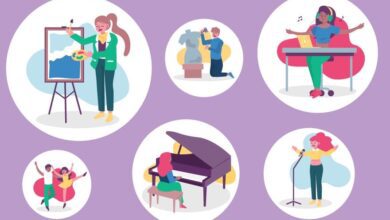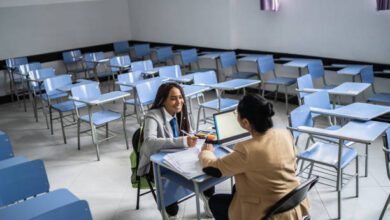What makes similarities formal and non formal education similar?


Introduction Formal and non formal education
Formal and non formal education is two types of learning that may seem very different at first glance. However, upon closer inspection, one can find that there are many similarities between these two approaches to education. While formal education takes place in a structured setting such as a school or university, non formal education occurs outside of traditional classrooms. Despite these differences, both types of education share similar characteristics that contribute to the overall learning experience. In this blog post, we will explore the similarities of formal and non formal education and how they both play a vital role in our personal and professional development.
The Goal of Learning
The goal of learning is a fundamental aspect of both formal and non formal education. Regardless of the setting, the ultimate aim of education is to acquire knowledge, skills, and understanding that can be applied in various aspects of life. Whether it is in a classroom or through experiential learning, the goal remains the same – to enhance our personal and professional development.
In both formal and non formal education, the goal is to equip individuals with the necessary tools to navigate through the complexities of life. It is about instilling a thirst for knowledge and a passion for lifelong learning. By setting clear objectives and learning outcomes, both types of education aim to provide individuals with a well-rounded education that prepares them for future challenges and opportunities.
Formal education often follows a standardized curriculum
That is designed to provide a structured and systematic approach to learning. It focuses on developing foundational knowledge and skills in various academic disciplines. On the other hand, non formal education allows for more flexibility and customization in learning. It provides opportunities for individuals to explore their interests and passions outside of the traditional classroom environment.
Despite these differences, the goal of learning in both formal and non formal education is to foster critical thinking, problem-solving, and creativity. It is about nurturing curiosity and empowering individuals to think independently and critically. Both approaches recognize the importance of developing cognitive, emotional, and social skills that are essential for personal and professional success.
Moreover, the goal of learning in both similarities of formal and non formal education is not limited to acquiring knowledge alone. It extends to the development of practical skills that can be applied in real-life situations. Whether it is through hands-on activities, projects, or internships, both types of education emphasize the importance of experiential learning and practical application of knowledge.
In summary, the goal of learning in both formal and non formal education is to provide individuals with the necessary tools, knowledge, and skills to thrive in today’s ever-changing world. Both approaches aim to foster personal and professional development, encourage critical thinking, and promote lifelong learning. Whether it is in a classroom or outside of it, the ultimate goal remains the same – to empower individuals to become active and engaged learners in their pursuit of knowledge and growth.
Use of Teaching Resources
The use of teaching resources is a common aspect of both formal and non formal education. These resources play a crucial role in enhancing the learning experience and ensuring that students have access to a wide range of materials that support their learning goals.
In formal education, teaching resources are often provided by the institution, such as textbooks, lecture notes, and online learning platforms. These resources are carefully curated and aligned with the curriculum to ensure that students receive a comprehensive education. They are designed to present information in a structured and organized manner, making it easier for students to understand complex concepts and theories. Additionally, formal education often utilizes technology, such as interactive whiteboards, educational software, and online resources, to engage students and facilitate their learning process.
Non formal education relies on a variety of teaching
Resources that can be accessed both online and offline. These resources can include books, articles, videos, podcasts, workshops, and even real-world experiences. Non formal education emphasizes the use of experiential learning and hands-on activities, allowing individuals to learn through direct engagement and application of knowledge. Teaching resources in non formal education are often diverse and tailored to individual interests and needs. They provide opportunities for individuals to explore their passions and pursue self-directed learning.
Regardless of the type of education, teaching resources are used to supplement and enrich the learning process. They provide additional information, examples, and perspectives that enhance students’ understanding and stimulate their curiosity. Teaching resources can also promote critical thinking and problem-solving skills by presenting different viewpoints and encouraging students to evaluate information critically.
In both formal and non formal education, teachers and facilitators play a crucial role in selecting and utilizing teaching resources effectively. They ensure that the resources are relevant, up-to-date, and aligned with the learning objectives. Teachers can also adapt and personalize teaching resources to meet the diverse needs and learning styles of their students.
The Role of Teachers
The role of teachers is instrumental in both formal and non formal education. They play a crucial role in guiding and facilitating the learning process, as well as providing support and mentorship to students. While their responsibilities may vary slightly depending on the type of education, the core essence of their role remains the same – to inspire and empower learners.
In formal education, teachers are responsible for delivering structured lessons, following the curriculum, and assessing student progress. They have the important task of imparting knowledge, explaining complex concepts, and facilitating discussions in the classroom. Formal education teachers have expertise in their respective subjects and use their knowledge to create engaging and effective learning experiences.
They create lesson plans, develop assessments,
And provide feedback to help students grow academically. Additionally, teachers in formal education often serve as role models, fostering a positive learning environment and promoting values such as discipline, respect, and perseverance.
In non formal education, teachers take on a more flexible and facilitative role. They serve as guides, mentors, and facilitators of learning rather than being the sole source of information. Non formal education teachers encourage independent thinking, problem-solving, and creativity. They provide support and guidance to individuals pursuing self-directed learning and help them navigate through their chosen educational paths. Non formal education teachers often have expertise in specific areas or skills and share their knowledge through workshops, seminars, or one-on-one mentoring. They create a supportive and inclusive learning environment that allows individuals to explore their passions and interests.
Both in formal and non formal education,
Teachers are responsible for fostering a positive and inclusive learning environment. They create a safe space for students to ask questions, share ideas, and express their opinions. They encourage collaboration and peer-to-peer learning, recognizing that students can learn from each other. Teachers also provide emotional support and encouragement, recognizing that education is not only about academic achievements but also about personal growth and development.
In summary, the role of teachers is vital in both formal and non formal education. They inspire, guide, and facilitate the learning process, promoting critical thinking, fostering a love for learning, and empowering individuals to reach their full potential. Whether in a classroom or a nontraditional setting, teachers have a profound impact on shaping the educational journey and the personal and professional development of their students.
Fostering Social Interaction
Fostering social interaction is a key aspect of both formal and non-formal education. While the methods may differ, the importance of creating opportunities for students to interact with one another cannot be overstated.
In formal education, social interaction occurs within the confines of the classroom. It is through class discussions, group projects, and collaborative learning activities that students have the chance to engage with their peers. These interactions not only facilitate the exchange of ideas and knowledge, but also promote teamwork, communication skills, and the development of interpersonal relationships. Students learn from one another, gaining new perspectives and insights that they may not have considered on their own. They learn how to work effectively in a team, compromise, and respect different viewpoints. These skills are invaluable in the professional world, where teamwork and effective communication are highly valued.
Non-formal education also provides ample opportunities for social interaction.
Workshops, seminars, and extracurricular activities allow individuals to connect with others who share similar interests and passions. Whether it is a photography club, a dance class, or a coding workshop, these activities bring people together and create a sense of community. Non-formal education recognizes the importance of social connections in the learning process. By fostering social interaction, individuals can build networks, gain support from their peers, and find mentors who can guide them on their educational journey.
Social interaction in both similarities of formal and non formal education also extends beyond the immediate classroom or learning environment. With the advancements in technology, online platforms and communities have emerged as spaces for individuals to connect and interact with others who share similar interests. Online forums, discussion boards, and social media groups provide avenues for individuals to seek advice, share resources, and engage in meaningful discussions. These virtual spaces bridge geographical barriers and create opportunities for individuals to learn from people from different backgrounds and cultures.
In summary, fostering social interaction is an integral part of both formal and non-formal education. It allows individuals to connect with others, exchange ideas, and develop essential interpersonal skills. Whether it is in a traditional classroom, a workshop, or an online community, social interaction plays a vital role in enhancing the learning experience and preparing individuals for success in their personal and professional lives.
The Essence of Evaluation
Evaluation is a crucial component of both formal and non formal education. It is through evaluation that we assess the progress, understanding, and mastery of knowledge and skills. Evaluation provides valuable feedback to both learners and educators, helping them identify strengths, areas for improvement, and gaps in knowledge.
In formal education, evaluation often takes the form of quizzes, tests, exams, and assignments. These assessments are designed to measure students’ comprehension and application of the material covered in the curriculum. They provide a benchmark for measuring academic achievement and allow teachers to gauge the effectiveness of their teaching methods. Formal education evaluations also contribute to grading and ranking systems, which can motivate students to strive for excellence and maintain a sense of accountability.
Non formal education, on the other hand,
Since non formal education often emphasizes experiential learning, assessments can be project-based, performance-based, or portfolio-based. For example, a non formal education program focused on entrepreneurship may evaluate students based on the development and implementation of a business plan. These types of evaluations allow individuals to demonstrate their practical skills and showcase their creativity.
In both formal and non formal education, evaluation goes beyond measuring knowledge retention. It also assesses critical thinking skills, problem-solving abilities, communication skills, and the application of knowledge in real-world scenarios. Evaluation encourages individuals to think analytically, synthesize information, and present their ideas effectively. It helps them develop the skills necessary for success in their personal and professional lives.
Evaluation is not only for learners; it also serves as a tool for educators to improve their teaching methods. By analyzing evaluation results, educators can identify areas where students struggle, adapt their teaching strategies, and provide additional support where needed. Evaluation data can also inform curriculum development, ensuring that it remains relevant and aligned with current needs and trends.
The Outcome: Knowledge and Skills
The ultimate outcome of both similarities of formal and non formal education is the acquisition of knowledge and skills. Both types of education aim to equip individuals with the tools and abilities necessary to navigate through life and achieve personal and professional success.
Through formal education, individuals gain a broad foundation of knowledge in various academic disciplines. They develop a deep understanding of subjects such as math, science, literature, history, and more. Formal education also fosters critical thinking skills, problem-solving abilities, and the capacity to analyze and synthesize information. These skills are essential in the academic realm and are highly valued in many professional fields.
Non formal education, on the other hand, focuses on practical skills that can be applied in real-life situations. It offers individuals the opportunity to gain hands-on experience and develop specific competencies that align with their interests and goals. For example, similarities of formal and non formal education programs can teach skills such as coding, cooking, photography, woodworking, and many others. These skills provide individuals with a tangible asset that they can utilize in various aspects of their lives.


Formal and non formal education,
The outcome goes beyond mere knowledge and skills. Education also shapes individuals’ character, values, and worldview. It instills important qualities such as curiosity, resilience, adaptability, and empathy. Education empowers individuals to become lifelong learners, constantly seeking to expand their knowledge and refine their abilities.
Ultimately, the outcome of formal and non formal education is the development of well-rounded individuals who are capable of thriving in today’s complex and dynamic world. It prepares individuals to face challenges, embrace opportunities, and contribute positively to society. By equipping individuals with knowledge, skills, and a passion for learning, both types of education play a vital role in personal and professional development.
Conclusion
In conclusion, while similarities of formal and non formal education may have different settings and approaches, they share several key similarities that contribute to the overall learning experience. Both types of education have the goal of equipping individuals with the necessary knowledge, skills, and understanding to navigate through life successfully. They both strive to foster critical thinking, problem-solving, and creativity, and promote a passion for lifelong learning.
Both formal and non formal educations recognize the importance of teaching resources in enhancing the learning process. Whether it is through textbooks, online platforms, workshops, or real-world experiences. Teaching resources play a crucial role in supporting and enriching students’ educational journeys. Additionally, teachers play a vital role in both types of education by guiding and facilitating the learning process. Providing support and mentorship, and creating a positive and inclusive learning environment.
Social interaction is another shared aspect of formal and non formal education. Both types of education recognize the value of connecting with peers, exchanging ideas, and developing interpersonal skills. Whether it is through class discussions, group projects, workshops, or online communities. Social interaction provides opportunities for collaboration, teamwork, and the exchange of diverse perspectives.



